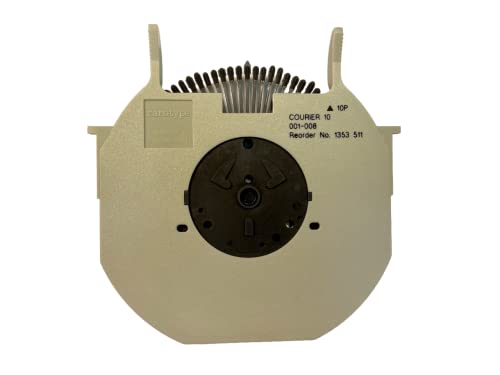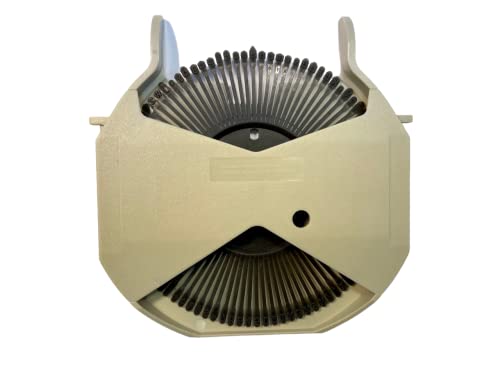
Unearthing a Typing Legend: A Deep Dive into the Rarotype IBM 1353511 Keyboard Review

Are you on a quest for the ultimate typing experience? Do you long for the satisfying click and tactile feedback that modern keyboards often lack? Then you’ve likely heard whispers of the legendary IBM Model M. Today, we’re taking a closer look at a specific, highly sought-after variant: the Rarotype IBM 1353511. This isn’t just a keyboard; it’s a piece of computing history, a workhorse designed for durability, and a potential game-changer for your daily typing.
For those unfamiliar, the IBM Model M, in all its iterations including the Rarotype IBM 1353511, is renowned for its “buckling spring” mechanism. Unlike the rubber domes or linear switches found in most modern keyboards, buckling springs provide a distinctive, crisp tactile bump and an equally distinctive auditory “click” with each key press. It’s an experience that harkens back to an era when keyboards were built to last decades, not just years.
What Makes the Rarotype IBM 1353511 Stand Out?
The 1353511 part number specifically refers to a version of the Model M often associated with a very robust, full-size layout and a P/S2 connector (though many users adapt them to USB). When you pick up a Rarotype IBM 1353511, the first thing you notice is its sheer weight and solid construction. This isn’t some flimsy plastic peripheral; it’s an absolute tank.
Key Features:
- Buckling Spring Switches: This is the heart and soul of the keyboard. Each key has a spring that buckles under pressure, providing a tactile and auditory feedback that many typists find incredibly addictive and precise.
- Legendary Durability: Built with a steel backplate and high-quality plastics, these keyboards were designed to withstand millions of key presses. It’s common to find Model Ms from the 80s and 90s still in perfect working order today.
- Classic Full-Size Layout: For those who appreciate dedicated function rows, a full number pad, and generously spaced keys, the 1353511 offers a familiar and comfortable layout for serious work.
- Excellent Keycap Quality: The keycaps are made of a durable PBT plastic, resistant to shine and wear over time, ensuring legends remain clear for years.
The Typing Experience: A Love Affair for Your Fingers
Typing on the Rarotype IBM 1353511 is, for many, an epiphany. The tactile feedback is incredibly satisfying, providing a clear indication of actuation that helps reduce errors and increase typing speed for some users. Each key press feels deliberate and precise.
Then there’s the sound. Oh, the sound! The audible click of the buckling springs is a signature characteristic. It’s often described as a loud, but pleasant, “thwack” or “clack.” For some, this sound is incredibly motivating and helps maintain a rhythm while typing. For others, particularly in quiet office environments, it can be a deal-breaker (more on that in the cons).
Pros:
- Unparalleled Typing Feel: The tactile feedback is second to none, making typing a truly enjoyable experience.
- Built Like a Tank: These keyboards are virtually indestructible and can last a lifetime.
- Classic Aesthetics: For fans of retro computing or industrial design, the look is iconic.
- Comfortable for Long Typing Sessions: The distinct feedback can help reduce finger fatigue by eliminating the need to “bottom out” keys.
The Practicalities: Weighing the Cons
While the Rarotype IBM 1353511 is a marvel of engineering, it’s not without its drawbacks, especially when viewed through a modern lens.
Cons:
- Noise Level: This is the big one. The buckling springs are LOUD. If you work in an open office, share a space, or simply prefer silence, this keyboard is probably not for you.
- Size and Weight: It’s a large, heavy keyboard. It takes up significant desk space and isn’t designed for portability.
- Connectivity: Most Model Ms, including the 1353511, use a P/S2 connector. You’ll need a reliable P/S2 to USB adapter to use it with modern computers, which adds a slight extra cost and potential point of failure.
- Lack of Modern Features: No backlighting, no media keys, no programmable macros. This is a purely functional typing instrument.
- Price (for well-maintained units): Due to their vintage appeal and reputation, well-preserved or refurbished Rarotype IBM 1353511 units can command a premium price. You can often find them available here: Rarotype IBM 1353511 on Amazon.
User Impressions: What People Are Saying
Across forums and review sites, the sentiment for the IBM Model M (and thus the Rarotype IBM 1353511) is overwhelmingly positive from its target audience. Users frequently describe it as the “best keyboard they’ve ever owned,” praising its indestructible nature and the sheer joy of typing on it. Many report a significant improvement in typing speed and accuracy.
The common complaint, as expected, revolves around the noise, with some users affectionately referring to it as “a machine gun for your fingers.” Others mention the need for a P/S2 adapter, but generally consider it a minor hurdle for the superior typing experience. It’s clear that for those who “get it,” the cons are easily outweighed by the pros.
Who Is the Rarotype IBM 1353511 Best For?
This classic keyboard isn’t for everyone, but for the right person, it’s a dream come true.
- Typing Enthusiasts and Purists: If you appreciate a tactile, auditory typing experience above all else, this is your holy grail.
- Writers, Programmers, and Data Entry Professionals: Anyone who spends extended periods typing will likely appreciate the comfortable feedback and durability.
- Retro Computing Enthusiasts: If you love vintage tech and want an authentic experience, this is a must-have.
- Anyone Tired of Mushy Modern Keyboards: If you’re fed up with membrane or low-quality mechanical keyboards, the Model M offers a stark and satisfying contrast.
- Collectors: As a piece of computing history, it holds significant value for collectors.
The Verdict: Is the Rarotype IBM 1353511 Worth the Investment?
Absolutely, for the right person. The Rarotype IBM 1353511 is more than just a peripheral; it’s an investment in a superior typing experience and a piece of computing heritage. While it might be loud, heavy, and require an adapter, the unrivaled build quality and the incredibly satisfying feel of the buckling springs make it a truly unique and worthwhile purchase for anyone serious about their typing.
If you’re ready to elevate your typing game and embrace the satisfying click of a true legend, don’t hesitate.
Ready to experience the legend for yourself?
Click here to check out the Rarotype IBM 1353511 on Amazon and start your journey to typing nirvana!
Rarotype IBM 1353511 on Amazon
FAQ
Q. What is the Rarotype IBM 1353511?
A. The Rarotype IBM 1353511 refers to a specific type element, often colloquially known as a “golf ball” or “typeball,” designed for use with IBM Selectric series electric typewriters. It is a spherical component containing all the characters (letters, numbers, symbols) of a particular font, which rotates and tilts to strike the paper through an ink ribbon.
Q. What is the primary function of this type element?
A. Its primary function is to enable the typewriter to print characters onto paper. Each Rarotype IBM 1353511 typeball contains a complete set of characters corresponding to a specific typeface and pitch (e.g., 10 or 12 characters per inch). By interchanging these elements, users could easily switch between different fonts and styles on a single typewriter.
Q. Which IBM typewriter models are compatible with the Rarotype IBM 1353511?
A. This type element is specifically designed for compatibility with the IBM Selectric I, Selectric II, and Selectric III typewriters. It may also be compatible with certain IBM Electronic Typewriter (ET) models that utilized the Selectric’s interchangeable typeball mechanism. It is not compatible with earlier IBM electric typewriters that used type bars or other non-Selectric mechanisms.
Q. What font style and size does the Rarotype IBM 1353511 produce?
A. While the “Rarotype” designation might imply a specific or less common typeface, without the actual font name printed on the element itself, it is difficult to determine the exact style. IBM typeballs came in a vast array of fonts, including common ones like Prestige Elite, Pica, Courier, and Letter Gothic, as well as specialized symbol sets or decorative fonts. The “Rarotype” prefix often indicates a specific, perhaps unique or less standard, version of a typeface or a specialized character set, typically with a defined pitch.
Q. Is the Rarotype IBM 1353511 considered a rare or collectible item?
A. While many IBM Selectric typeballs were mass-produced, specific or less common typefaces, particularly those with unique character sets or specialized designs (which “Rarotype” might suggest), can be quite rare and collectible. Collectors of vintage typewriters, historical document enthusiasts, or those seeking specific fonts often value these specialized type elements. Its rarity largely depends on the specific font it carries and the demand within the collector community.
Q. How can one properly identify and care for a Rarotype IBM 1353511 type element?
A. Proper identification involves checking for the “IBM 1353511” part number, which is typically molded or stamped onto the base or side of the typeball. The specific font name is also usually printed on the side of the element. For care, store type elements in their original plastic cases or in a clean, dust-free container to protect the delicate characters. Avoid touching the characters directly to prevent oil residue buildup. If cleaning is necessary, use a soft, dry brush or compressed air to gently remove dust, and never use harsh chemicals or abrasive materials.
Q. Why would someone use a “Rarotype” font instead of a standard one?
A. Users would typically choose a “Rarotype” font for specialized purposes that required a unique aesthetic or specific characters not available in standard typeballs. This could include technical documentation, specialized reports, unique letterhead, foreign language characters, mathematical symbols, or even decorative text for newsletters or announcements. The ability to quickly swap type elements made Selectric typewriters highly versatile for professionals needing diverse typographic options.
